Emerging Technologies Transforming Omnichannel Contact Centres
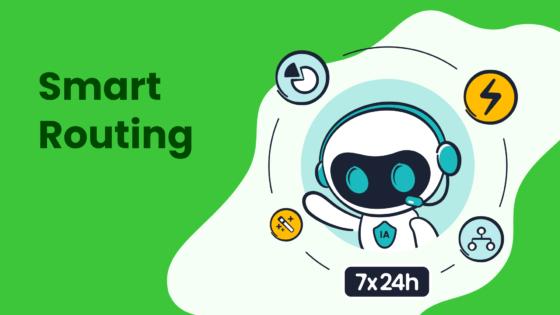
Emerging technologies such as AI, cloud platforms, and advanced digital solutions now drive the rapid transformation of the omnichannel contact centre. Businesses face urgent pressure to meet new digital customer expectations. Nearly 50% of support units use AI, with 52% investing in Conversational AI and 69% reporting improved service. Modern contact center platforms leverage predictive routing, generative AI, and cloud-based tools for real-time insights and cost savings. Sobot leads with intelligent omnichannel contact centre solutions, using Sobot AI to unify digital interactions and boost operational efficiency for brands worldwide.
Omnichannel Contact Centre Trends
Digital Acceleration
The digital landscape for contact centers continues to evolve at a rapid pace. In 2025, digital transformation stands as a top priority for organizations aiming to deliver outstanding customer experiences. Companies now invest heavily in digital tools that support omnichannel contact centre operations. These tools help agents manage customer interactions across multiple platforms, such as phone, email, chat, and social media.
Key trends include:
- Omnichannel integration for seamless and consistent customer experiences.
- AI and automation for faster response times and improved efficiency.
- Advanced analytics to gain deeper insights into customer behavior.
- Support for remote and hybrid work models.
The market for cloud-based contact center solutions shows strong growth. According to recent data, the global CCaaS (Contact Center as a Service) market is projected to reach $7.9 billion in 2025, with an 18% CAGR from 2022 to 2032. Customer experience remains the main driver for these investments, with 85% of businesses prioritizing CX improvements.
| Metric/Year | Value/Projection |
|---|---|
| CCaaS Market Revenue 2022 | USD 4.7 billion |
| CCaaS Market Revenue 2023 | USD 5.5 billion |
| CCaaS Market Revenue 2024 | USD 6.4 billion |
| CCaaS Market Revenue 2025 | USD 7.9 billion |
| CAGR (2022-2032) | 18% |
| BFSI Sector Market Share | 25% |
| Customer Experience as Investment Driver (2019) | 85% |
| Customer Expectation from CCaaS Vendors (2022) | 66% expect companies to understand their needs |
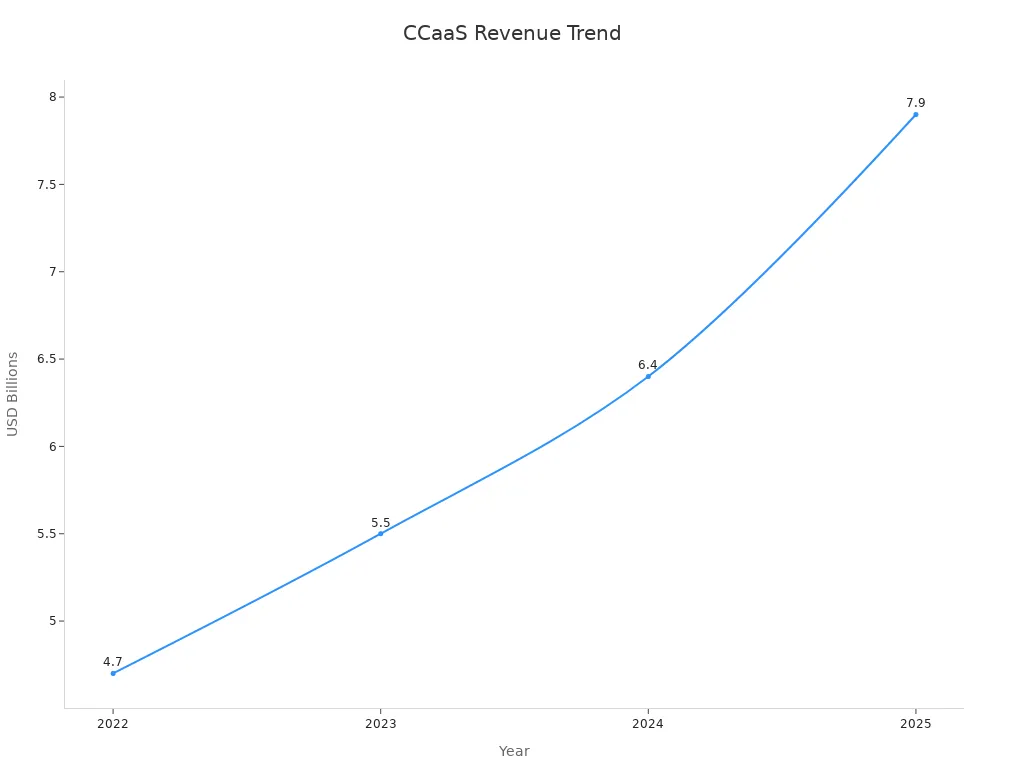
Seamless Channel Integration
Seamless channel integration has become essential for every omnichannel contact centre. Businesses now recognize that customers expect consistent service, no matter which channel they use. Omnichannel communication allows agents to view all customer interactions in one place, reducing wait times and improving satisfaction.
Sobot leads this transformation with its omnichannel solution. The platform unifies digital channels, giving agents a single workspace to manage phone calls, emails, chats, and social media messages. This approach boosts agent productivity and ensures a smooth customer journey. For example, Opay, a financial service provider, used Sobot to increase customer satisfaction from 60% to 90% by integrating all digital touchpoints into one system.
Companies that adopt unified omnichannel cx platforms see higher efficiency and better customer loyalty. Omnichannel cx is no longer optional—it is a necessity for success in the digital era.
AI and Automation
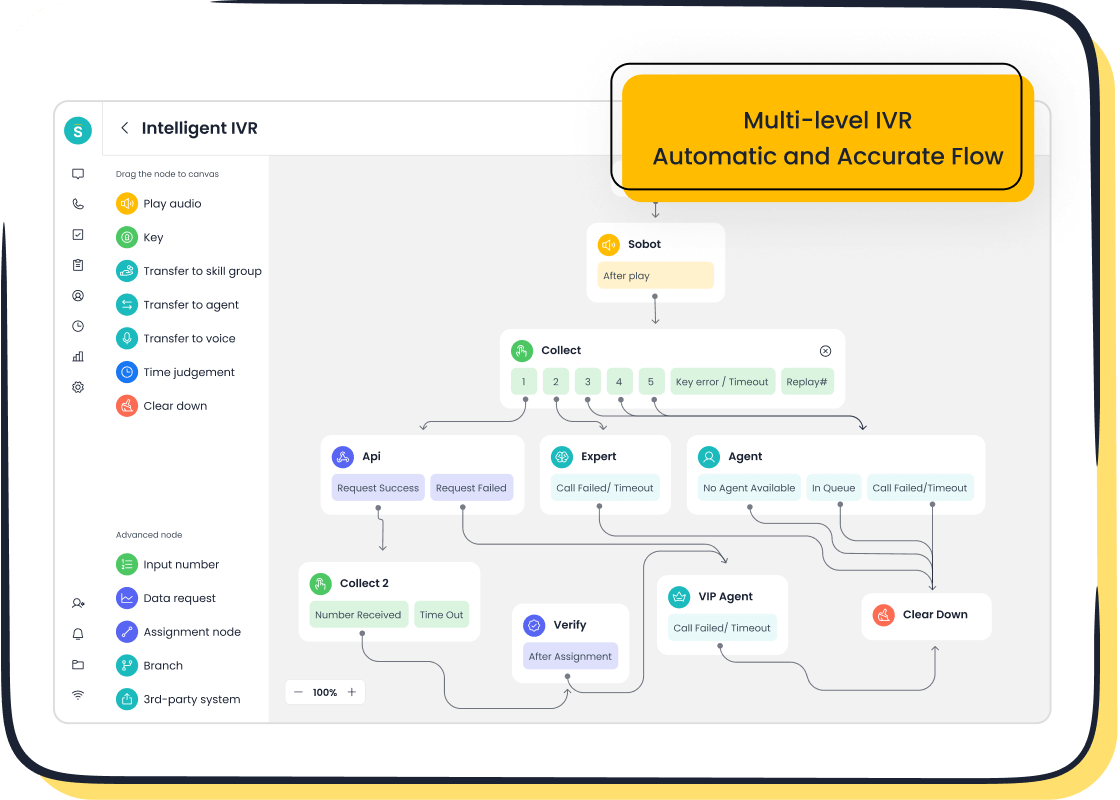
Conversational AI
Contact center technology has changed rapidly with the rise of conversational AI chatbots and AI voice bots. These tools now handle routine questions, freeing agents to focus on complex issues. Companies see big improvements in customer experience when they use chatbots and AI voice bots for first-line support. For example, H&M uses AI-powered chatbots to resolve 70% of customer queries without human help. This leads to three times faster response times and a 25% increase in conversions.
Sobot’s AI-powered Voice/Call Center and multilingual chatbots offer 24/7 support across channels. These conversational AI chatbots understand customer intent, answer questions, and even guide users through self-service options. AI voice bots can recognize speech, route calls, and provide instant answers. This reduces wait times and improves satisfaction. In fact, 69% of customers feel frustrated when waiting on hold, but AI voice bots help solve this problem by providing immediate responses.
| Company | AI Application | Impact on Customer Experience | Impact on Agent Productivity / Operational Efficiency |
|---|---|---|---|
| H&M | AI-powered chatbots | 70% query resolution without human intervention; 3x faster response times; increased conversions by 25% | Reduced support costs; improved customer satisfaction |
| NIB | AI digital assistant (Nibby) | 60% reduction in human support needs; 15% fewer calls to agents | $22 million savings; managed growth without proportional staff increase |
| Verizon | Generative AI for call prediction | Reduced store visit duration by ~7 minutes; prevented 100,000 customer churn | Efficient call routing to appropriate agents; enhanced loyalty |
| eHealth | AI voice agents | Eliminated after-hours wait times; doubled customer interest in plans; 60% rated experience as exceptional | Handled high call volumes without increasing operational costs |
| Teleperformance | AI accent neutralization | Improved communication clarity; reduced call durations; increased customer satisfaction | Enhanced agent-customer communication efficiency |
| Commonwealth Bank | AI for wait time reduction and security | Improved service efficiency and security measures | Enhanced operational efficiency and fraud prevention |
Sobot’s chatbots and AI voice bots also help companies reduce unanswered calls by 30% and lower common friction points by 66%. These improvements lead to higher customer satisfaction and better business outcomes.
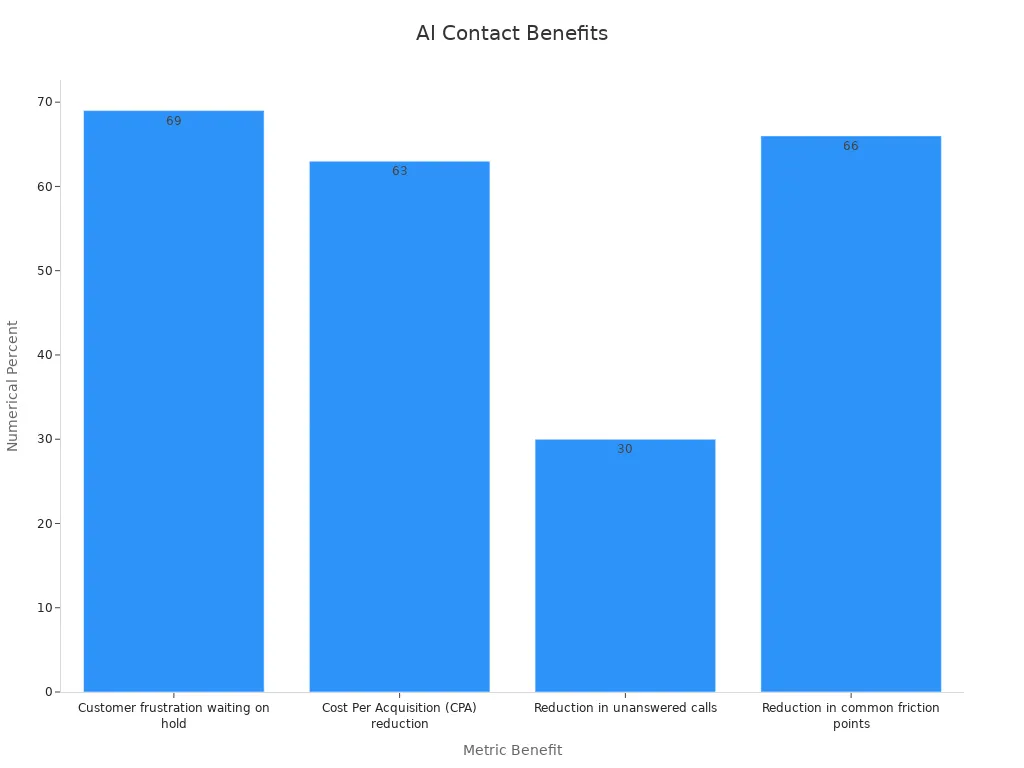
Agent Assistance
AI in the contact center does more than just answer customer questions. AI agent assist solutions give agents real-time suggestions and information during calls or chats. This support helps agents solve problems faster and with more confidence. For example, intelligent call routing uses AI to connect customers to the best-suited agent, improving first-call resolution rates and reducing repeat contacts.
Sobot’s unified workspace combines chatbots, AI voice bots, and agent assist tools. Agents see all customer data and conversation history in one place. AI agent assist solutions analyze conversations, suggest responses, and even detect customer emotions using sentiment analysis. This allows agents to adjust their approach and deliver a more personal customer experience.
Contact center technology powered by AI and automation also automates repetitive tasks, such as ticket creation and follow-up reminders. This reduces operational costs and balances agent workloads, especially during peak times. Companies like NIB saved $22 million by using AI digital assistants, while eHealth handled high call volumes without hiring more staff.
Tip: Companies that use AI agent assist solutions and automation see faster response times, higher customer satisfaction, and more efficient operations.
Contact center technology continues to evolve. AI in the contact center now plays a key role in delivering seamless, personalized, and efficient customer experiences. Sobot’s AI-powered solutions help businesses stay ahead by improving both customer experience and agent productivity.
Cloud Contact Center Transformation
Scalability and Flexibility
The shift to cloud has transformed how organizations manage customer interactions. Companies now choose cloud-based contact center platforms to scale operations quickly and adapt to changing business needs. Traditional on-premises systems often require large investments in hardware and IT support. In contrast, cloud-based solutions allow businesses to add or remove users, channels, and features with just a few clicks.

Sobot’s Voice/Call Center demonstrates this flexibility. Businesses can deploy the platform rapidly, access global phone numbers, and integrate with existing CRM systems. The system supports high call volumes and offers a 99.99% uptime, ensuring reliable service for customers worldwide. Companies benefit from seamless integration and real-time analytics, which help them make informed decisions and optimize resources.
Key benefits of cloud-based contact center technology include:
- Rapid deployment and easy scaling for seasonal demand or business growth.
- Access to advanced features like intelligent IVR, AI-powered voicebots, and unified workspaces.
- Global reach, with support for multiple languages and time zones.
- Cost savings, as switching to VoIP can reduce expenses by up to 65% compared to traditional landlines.
- 82% of small businesses report lower costs after moving to cloud-based solutions.
Companies that invest in cloud-based contact center technology gain a competitive edge by responding faster to market changes and customer needs.
Remote Workforce
Cloud contact center technology supports remote workforces by enabling agents to work from anywhere with an internet connection. This flexibility has become essential for modern businesses. Agents can access the same tools and data whether they work from home, a branch office, or another country.
Sobot’s Voice/Call Center offers multi-device compatibility, allowing agents to handle calls and messages on desktops, laptops, or mobile devices. Real-time monitoring and analytics help managers track performance and ensure quality service, no matter where agents are located. The platform’s secure, encrypted data transfer protects sensitive customer information.
Industry trends show a strong move toward remote work:
- IDC predicts cloud infrastructure spending will surpass on-premises investments, with 54% of organizations choosing cloud.
- The cloud contact center market is growing at a 26% CAGR through 2027, reflecting rapid adoption.
- Cloud-based contact center technology enables real-time reporting and collaboration for distributed teams.
Sobot’s solution empowers businesses to build agile, efficient teams that deliver consistent customer experiences across the globe. Companies reduce costs related to office space and IT infrastructure, while agents enjoy greater flexibility and work-life balance.
Cloud-based solutions make it possible for organizations to attract and retain top talent, regardless of location.
Customer Experience Personalization

Data-Driven Insights
Contact centers now rely on data-driven insights to deliver meaningful personalization. By analyzing customer data, organizations can understand preferences, behaviors, and pain points. This approach helps agents tailor every interaction, making each customer experience unique. Key performance indicators (KPIs) such as customer satisfaction (CSAT), Net Promoter Score (NPS), and First Call Resolution (FCR) guide teams toward better outcomes. Quality assurance evaluations and post-interaction surveys provide valuable feedback for continuous improvement.
Contact centers use predictive analytics to forecast call volumes and identify peak times. Conversation intelligence tools analyze speech and text, surfacing trends and customer sentiment. These insights allow businesses to optimize resources and deliver personalized experiences at scale. Sobot’s omnichannel solution empowers agents with a unified workspace, giving them access to real-time customer data and conversation history. This enables agents to provide a personalized customer experience that aligns with organizational goals.
Organizations that align KPIs with business objectives and refine them regularly see higher customer satisfaction and improved cx outcomes.
Real-Time Analytics
Real-time analytics play a crucial role in enhancing customer experience. Advanced analytics platforms use machine learning and AI to process large volumes of data instantly. These tools track important metrics such as average handle time, call abandonment rates, and call transfer rates. By monitoring these metrics, managers can quickly identify issues and coach agents for better performance.
Empowering agents with real-time data boosts motivation and enables faster, more accurate responses. Sobot’s platform offers real-time monitoring and analytics, helping teams spot trends and adjust strategies on the fly. This data-driven culture encourages continuous improvement and innovation. Companies that use real-time analytics report higher first call resolution rates and increased customer loyalty. According to industry research, organizations that leverage analytics for cx see measurable gains in efficiency and satisfaction.
Omnichannel Integration
Unified Workspace
Unified workspaces have become essential in modern contact center technology. Agents need quick access to customer information and conversation history across all channels. A unified workspace brings together phone, chat, email, and social media interactions in one place. This setup helps agents respond faster and deliver more personalized service.
Sobot’s omnichannel solution provides a single dashboard for agents. They can view complete customer histories and manage every interaction without switching platforms. This approach leads to measurable improvements:
- A retail company saw a 30% reduction in response times and a 25% increase in customer satisfaction after adopting an integrated support system.
- Centralized data access allows agents to personalize each interaction, improving the overall cx.
- Analytics and reporting tools help managers track key metrics, supporting continuous improvement.
Unified workspaces also support collaboration between departments. Agents can share information and resolve issues more efficiently. Businesses that use unified workspaces scale their support operations smoothly, maintaining high service quality as they grow.
Cross-Channel Consistency
Cross-channel consistency ensures customers receive the same quality of service, no matter which channel they choose. Omnichannel cx depends on seamless integration between communication platforms. Customers do not want to repeat information or experience delays when switching from chat to phone or email.
Sobot’s omnichannel platform enables agents to follow every customer journey across channels. Integrated translation services help international brands deliver consistent support in multiple languages. For example, a hospitality brand improved feedback from non-English speakers by ensuring quality across regions.
Key benefits of cross-channel consistency include:
- Elimination of repeated questions, leading to smoother interactions.
- Proactive service, such as alerts for declining product usage.
- Scalability, allowing businesses to expand support without losing quality.
Contact center technology that supports cross-channel consistency builds trust and loyalty. Customers appreciate a seamless experience, which leads to higher satisfaction and retention.
Security and Compliance
Data Privacy
Data privacy stands at the core of every modern omnichannel contact centre. Customers trust companies with sensitive information, such as names, addresses, and payment details. Organizations must protect this data to avoid legal issues and maintain customer confidence. Recent compliance reports show that 53% of professionals consider managing data privacy risks absolutely essential for contact centres. Cybersecurity remains the highest risk area, with 65% of compliance leaders ranking it as their top concern.
| Aspect | Statistic / Insight | Relevance to Data Privacy and Trust in Contact Centres |
|---|---|---|
| Data Privacy & IT Security Importance | 53% and 52% of professionals consider managing data privacy and IT security risks absolutely essential | Directly supports criticality of data privacy and trust in environments like contact centres |
| Highest Risk Areas | Cybersecurity (65%), IT (51%), third-party relationships (41%), compliance/regulatory (41%) | Cybersecurity and compliance risks are top concerns directly impacting contact centre data privacy |
| Cost of Data Breaches | Breaches cost ~$220,000 more when non-compliance involved | Financial impact underscores need for robust compliance in contact centres |
Sobot’s omnichannel contact centre solutions use encrypted data transfer and secure cloud infrastructure to protect customer information. The platform supports compliance with global regulations, helping businesses avoid costly breaches. Sobot also provides real-time monitoring and analytics, so teams can spot risks early and take action.
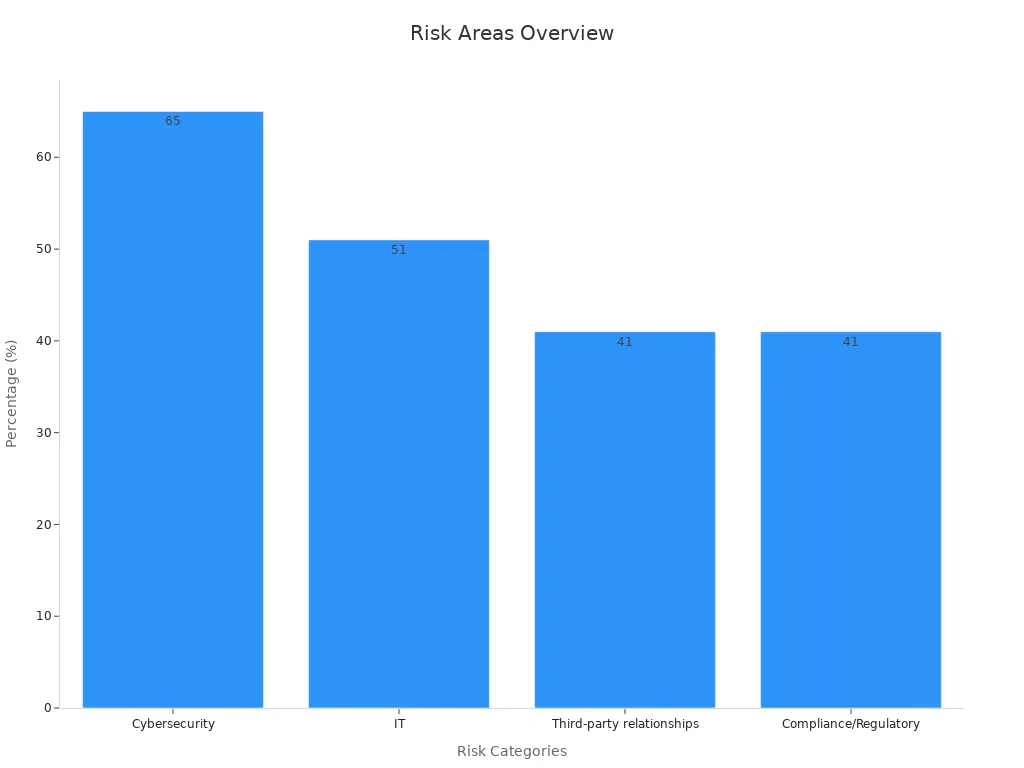
Trust and Transparency
Trust and transparency shape the reputation of every omnichannel contact centre. Customers expect companies to handle their data with care and honesty. According to industry research, 76% of risk and compliance professionals prioritize building an ethical compliance culture. This focus helps organizations earn and keep customer trust.
Contact centres must communicate privacy policies clearly and respond quickly to customer concerns. Sobot’s platform supports these goals by offering transparent data handling and audit trails. The system allows businesses to monitor compliance tasks, such as risk assessment and training, which 60% of organizations plan to expand in the next three years. Sobot’s commitment to security and compliance helps brands build long-term loyalty and meet the highest standards in customer experience.
Tip: Companies that invest in robust security and transparent practices see higher customer satisfaction and fewer legal issues. For more on compliance best practices, visit Gartner’s insights on data privacy.
Omnichannel contact centre technology must keep evolving to address new risks. By prioritizing data privacy and trust, organizations can protect their customers and their brand reputation.
Contact Center Industry Trends 2025
Self-Service and Mobile
Self-service stands out as a defining trend in contact center industry trends for 2025. Customers now expect brands to offer instant answers and support at any time. Research from Statista shows that 88% of customers want online self-service portals. Companies respond by investing in knowledge bases, FAQs, and AI-powered chatbots. These tools allow users to solve problems without waiting for a live agent. AI-driven virtual assistants guide customers through troubleshooting steps, making the experience smoother and more efficient.
Self-service options operate 24/7. This reduces the workload for agents and improves response times. Businesses see lower support costs and higher satisfaction rates. Bank of America’s "Erica" chatbot has handled billions of interactions, showing how chatbots and virtual assistants shape mobile engagement. Sobot’s omnichannel platform includes AI-powered chatbots and customer self-service solutions, helping brands deliver fast, reliable support across devices. As more consumers use mobile devices, companies must ensure their self-service tools work seamlessly on smartphones and tablets.
Customers interact across an average of eight channels. 71% switch channels based on their needs, highlighting the importance of mobile-friendly self-service.
Social Media Engagement
Social media engagement continues to grow as a key part of contact center industry trends. Customers reach out on platforms like WhatsApp, Facebook, and Twitter for quick support. Speed and responsiveness matter—half of customers say they are less likely to buy if response times are slow. Companies use chatbots to answer common questions on social media, providing instant help and freeing agents for complex issues.
Sobot’s omnichannel solution integrates social media channels, allowing agents to manage all conversations in one workspace. Real-time analytics help teams track trends and improve service quality. Businesses that engage customers on social media build stronger relationships and boost loyalty. As the CCaaS market expands, social media engagement will remain vital for customer experience.
Overcoming Challenges
Change Management
Change management remains a critical factor in the success of omnichannel contact center transformation. Many organizations struggle to help teams adapt to new technologies and workflows. Studies show that projects with excellent change management are about seven times more likely to meet their objectives. Adoption rates can reach 95% with structured change management, compared to only 35% without it. Companies with mature change management practices report 50% higher project success rates.
Key strategies for effective change management include:
- Setting clear goals and success criteria from the start.
- Providing regular training and support for agents and managers.
- Communicating updates and progress to all stakeholders.
- Using visual dashboards to track adoption and performance.
Sobot supports organizations by offering intuitive platforms and comprehensive onboarding resources. This approach helps teams adjust quickly and reduces resistance to new systems. In industries like retail and financial services, structured change management leads to 20-30% faster adoption and 15-25% higher customer satisfaction.
Projects that invest in change management realize benefits 30-50% faster and reduce implementation costs by up to 40%.
Measuring ROI
Measuring ROI in contact centers requires a focus on both financial and operational metrics. Typical ROI for change management ranges from 3:1 to 7:1, meaning every dollar invested returns $3 to $7. Organizations track key metrics such as First Call Resolution (FCR), Customer Satisfaction Score (CSAT), Average Handle Time (AHT), agent turnover rate, and AI utilization rate.
A balanced scorecard approach works best. This method combines financial, customer, operational, and people metrics. For example, Sobot’s analytics tools allow managers to monitor FCR, CSAT, and service levels in real time. Regular assessment cycles, from 30 days to one year, help teams adjust strategies and sustain improvements.
| Metric | Why It Matters |
|---|---|
| FCR | Higher rates mean better problem solving |
| CSAT | Directly reflects customer happiness |
| AHT | Lower times show greater efficiency |
| Agent Turnover | Lower rates reduce training costs |
| AI Utilization | Shows success of automation adoption |
Transparent reporting and regular updates build trust and help organizations communicate the value of their investments.
Future of Contact Center Transformation
Next-Gen Technologies
Contact center transformation will accelerate as new technologies emerge. Companies now focus on tools that improve both customer and agent experiences. Several trends shape the future:
- Natural Language Processing (NLP) continues to evolve. It helps systems understand customer emotions and intent, making self-service smarter and speech analytics more accurate.
- Conversational AI and voice assistants use real-time data to deliver fast, human-like support. By 2025, experts predict AI will resolve most customer inquiries, reducing the need for human agents.
- AI-powered analytics process large amounts of data. These tools give managers insights to improve satisfaction and agent performance.
- Security and compliance remain top priorities. AI now supports biometric authentication and real-time monitoring, helping companies reduce legal risks.
- Cloud platforms enable flexible, scalable solutions. Businesses can add new channels or features quickly, supporting remote and hybrid teams.
Sobot’s omnichannel platform already uses AI, NLP, and cloud technology to help brands deliver seamless, secure, and efficient service. For example, Sobot’s AI-powered chatbots and voicebots provide 24/7 support, while real-time analytics help teams make better decisions.
Companies that blend human expertise with next-gen AI tools see higher customer satisfaction and lower costs.
Strategic Priorities
Organizations set clear priorities to guide contact center transformation. Industry reports highlight several focus areas:
| Strategic Priority | Description |
|---|---|
| AI and Automation | Invest in conversational AI, NLP, and automation to boost efficiency. |
| Cloud Adoption | Use cloud platforms for flexibility, cost savings, and global reach. |
| Security and Compliance | Enhance security with multi-factor authentication and updated policies. |
| Omnichannel Support | Provide seamless digital support with easy human backup. |
| Advanced Analytics | Leverage predictive insights to improve service and sales targeting. |
| Agent Training | Develop AI-driven, gamified training for hybrid workforces. |
| Self-Service Expansion | Increase self-service options to handle more inquiries without more staff. |
Sobot aligns with these priorities by offering secure, cloud-based solutions that support omnichannel integration and advanced analytics. As digital transformation continues, companies that invest in these areas will stay ahead of customer expectations and industry changes. For more on future trends, see Metrigy’s 2024-2025 CX report.
Emerging technologies like AI, cloud platforms, and omnichannel analytics drive real change in the omnichannel contact center. Companies see benefits such as lower average handle time, higher first call resolution, and improved customer satisfaction. Sobot’s unified solutions help organizations use real-time data, sentiment analytics, and cross-channel insights to optimize every customer interaction. To stay ahead, leaders should invest in adaptable platforms, measure key metrics, and use analytics to guide decisions. Start by evaluating current workflows and exploring solutions that unify channels and boost operational efficiency.
FAQ
What is an omnichannel contact center?
An omnichannel contact center uses contact center technology to connect all customer communication channels. Agents can manage phone, chat, email, and social media in one place. Sobot’s omnichannel solution helps brands deliver seamless support and improve customer satisfaction. Learn more.
How does AI improve contact center technology?
AI in contact center technology automates routine tasks, provides instant answers, and supports agents with real-time suggestions. Sobot’s AI-powered chatbots and voicebots resolve up to 70% of common queries, reducing wait times and boosting efficiency.
Why is cloud-based contact center technology important?
Cloud-based contact center technology offers scalability and flexibility. Companies can add users or features quickly. Sobot’s Voice/Call Center provides 99.99% uptime and global reach, supporting remote teams and ensuring reliable service for customers worldwide.
How does Sobot ensure data privacy in its omnichannel contact center?
Sobot uses encrypted data transfer and secure cloud infrastructure to protect customer information. The platform complies with global regulations, helping businesses avoid costly breaches and maintain trust. Data privacy remains a top priority in every Sobot omnichannel contact center deployment.
What results can businesses expect from Sobot’s omnichannel contact center solutions?
Businesses using Sobot’s omnichannel contact center solutions report higher customer satisfaction, lower operational costs, and improved agent productivity. For example, Opay increased customer satisfaction from 60% to 90% after integrating Sobot’s unified platform. Read the case study.
Tip: Companies that invest in advanced contact center technology see measurable gains in efficiency and customer loyalty.
See Also
How To Successfully Deploy Omnichannel Contact Center Systems
Comprehensive Overview Of Omnichannel Call Center Platforms
Best Contact Center Technologies Evaluated For 2024
